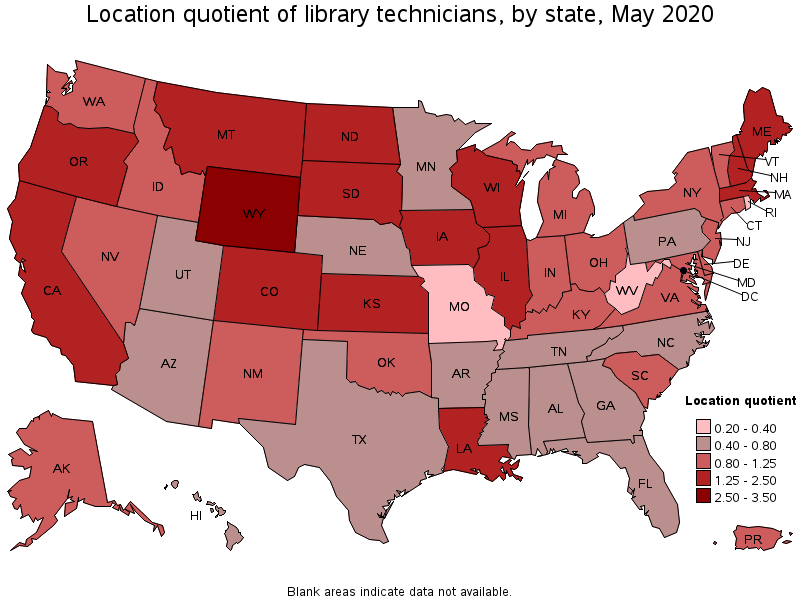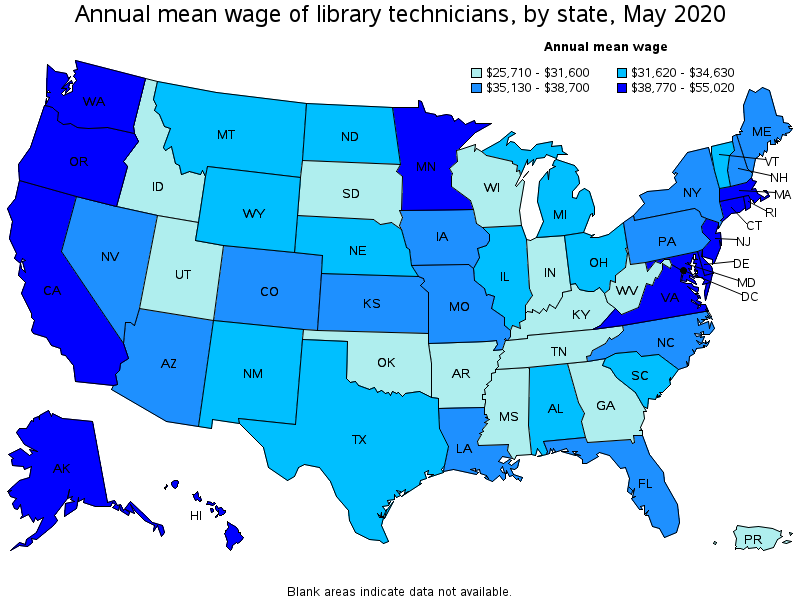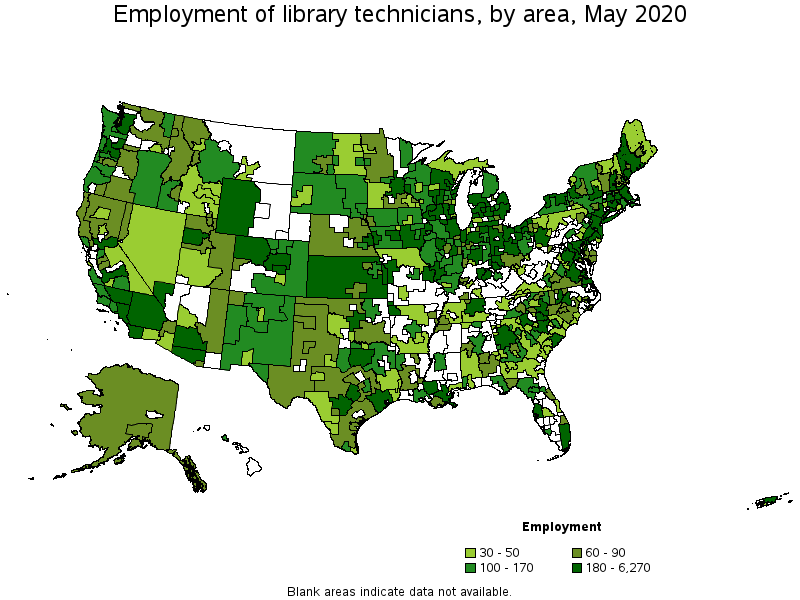An official website of the United States government
 United States Department of Labor
United States Department of Labor
Assist librarians by helping readers in the use of library catalogs, databases, and indexes to locate books and other materials; and by answering questions that require only brief consultation of standard reference. Compile records; sort and shelve books or other media; remove or repair damaged books or other media; register patrons; and check materials in and out of the circulation process. Replace materials in shelving area (stacks) or files. Includes bookmobile drivers who assist with providing services in mobile libraries.
Employment estimate and mean wage estimates for Library Technicians:
| Employment (1) | Employment RSE (3) |
Mean hourly wage |
Mean annual wage (2) |
Wage RSE (3) |
|---|---|---|---|---|
| 89,070 | 4.7 % | $ 19.05 | $ 39,630 | 2.6 % |
Percentile wage estimates for Library Technicians:
| Percentile | 10% | 25% | 50% (Median) |
75% | 90% |
|---|---|---|---|---|---|
| Hourly Wage | $ 11.11 | $ 13.50 | $ 17.79 | $ 23.27 | $ 29.64 |
| Annual Wage (2) | $ 23,110 | $ 28,080 | $ 37,010 | $ 48,400 | $ 61,650 |
Industries with the highest published employment and wages for Library Technicians are provided. For a list of all industries with employment in Library Technicians, see the Create Customized Tables function.
Industries with the highest levels of employment in Library Technicians:
| Industry | Employment (1) | Percent of industry employment | Hourly mean wage | Annual mean wage (2) |
|---|---|---|---|---|
| Local Government, excluding schools and hospitals (OEWS Designation) | 46,110 | 0.85 | $ 17.33 | $ 36,040 |
| Elementary and Secondary Schools | 12,560 | 0.15 | $ 18.07 | $ 37,590 |
| Colleges, Universities, and Professional Schools | 11,600 | 0.38 | $ 20.64 | $ 42,940 |
| Junior Colleges | 2,740 | 0.40 | $ 19.86 | $ 41,300 |
| State Government, excluding schools and hospitals (OEWS Designation) | 1,240 | 0.06 | $ 22.43 | $ 46,650 |
Industries with the highest concentration of employment in Library Technicians:
| Industry | Employment (1) | Percent of industry employment | Hourly mean wage | Annual mean wage (2) |
|---|---|---|---|---|
| Local Government, excluding schools and hospitals (OEWS Designation) | 46,110 | 0.85 | $ 17.33 | $ 36,040 |
| Junior Colleges | 2,740 | 0.40 | $ 19.86 | $ 41,300 |
| Colleges, Universities, and Professional Schools | 11,600 | 0.38 | $ 20.64 | $ 42,940 |
| Elementary and Secondary Schools | 12,560 | 0.15 | $ 18.07 | $ 37,590 |
| Museums, Historical Sites, and Similar Institutions | 110 | 0.08 | $ 19.47 | $ 40,500 |
Top paying industries for Library Technicians:
| Industry | Employment (1) | Percent of industry employment | Hourly mean wage | Annual mean wage (2) |
|---|---|---|---|---|
| Management of Companies and Enterprises | 40 | (7) | $ 30.08 | $ 62,560 |
| Computer Systems Design and Related Services | 30 | (7) | $ 27.06 | $ 56,290 |
| Federal Executive Branch (OEWS Designation) | 540 | 0.03 | $ 26.20 | $ 54,490 |
| Legal Services | 150 | 0.01 | $ 25.86 | $ 53,800 |
| State Government, excluding schools and hospitals (OEWS Designation) | 1,240 | 0.06 | $ 22.43 | $ 46,650 |
States and areas with the highest published employment, location quotients, and wages for Library Technicians are provided. For a list of all areas with employment in Library Technicians, see the Create Customized Tables function.

States with the highest employment level in Library Technicians:
| State | Employment (1) | Employment per thousand jobs | Location quotient (9) | Hourly mean wage | Annual mean wage (2) |
|---|---|---|---|---|---|
| California | 15,690 | 0.96 | 1.49 | $ 25.72 | $ 53,490 |
| New York | 6,870 | 0.79 | 1.23 | $ 18.12 | $ 37,680 |
| Illinois | 6,290 | 1.12 | 1.75 | $ 16.31 | $ 33,930 |
| Texas | 3,970 | 0.33 | 0.51 | $ 15.57 | $ 32,380 |
| Ohio | 3,530 | 0.69 | 1.07 | $ 16.52 | $ 34,360 |

States with the highest concentration of jobs and location quotients in Library Technicians:
| State | Employment (1) | Employment per thousand jobs | Location quotient (9) | Hourly mean wage | Annual mean wage (2) |
|---|---|---|---|---|---|
| Wyoming | 520 | 1.98 | 3.10 | $ 15.20 | $ 31,620 |
| South Dakota | 500 | 1.21 | 1.90 | $ 13.35 | $ 27,760 |
| Montana | 550 | 1.20 | 1.87 | $ 15.29 | $ 31,810 |
| Illinois | 6,290 | 1.12 | 1.75 | $ 16.31 | $ 33,930 |
| Colorado | 2,760 | 1.07 | 1.67 | $ 17.32 | $ 36,030 |

Top paying states for Library Technicians:
| State | Employment (1) | Employment per thousand jobs | Location quotient (9) | Hourly mean wage | Annual mean wage (2) |
|---|---|---|---|---|---|
| District of Columbia | 660 | 0.96 | 1.50 | $ 26.45 | $ 55,020 |
| California | 15,690 | 0.96 | 1.49 | $ 25.72 | $ 53,490 |
| Rhode Island | 110 | 0.25 | 0.38 | $ 25.38 | $ 52,790 |
| Connecticut | 1,030 | 0.67 | 1.04 | $ 24.96 | $ 51,910 |
| Washington | 2,280 | 0.71 | 1.11 | $ 24.29 | $ 50,530 |

Metropolitan areas with the highest employment level in Library Technicians:
| Metropolitan area | Employment (1) | Employment per thousand jobs | Location quotient (9) | Hourly mean wage | Annual mean wage (2) |
|---|---|---|---|---|---|
| New York-Newark-Jersey City, NY-NJ-PA | 6,270 | 0.71 | 1.11 | $ 19.41 | $ 40,370 |
| Chicago-Naperville-Elgin, IL-IN-WI | 4,500 | 1.03 | 1.61 | $ 16.95 | $ 35,250 |
| Los Angeles-Long Beach-Anaheim, CA | 2,520 | 0.43 | 0.68 | $ 23.19 | $ 48,230 |
| Boston-Cambridge-Nashua, MA-NH | 2,040 | 0.79 | 1.23 | $ 24.59 | $ 51,160 |
| Washington-Arlington-Alexandria, DC-VA-MD-WV | 2,030 | 0.67 | 1.05 | $ 22.70 | $ 47,220 |
| Seattle-Tacoma-Bellevue, WA | 1,530 | 0.78 | 1.22 | $ 25.62 | $ 53,300 |
| Miami-Fort Lauderdale-West Palm Beach, FL | 1,210 | 0.48 | 0.75 | $ 16.88 | $ 35,100 |
| Denver-Aurora-Lakewood, CO | 1,050 | 0.72 | 1.13 | $ 18.39 | $ 38,250 |
| Atlanta-Sandy Springs-Roswell, GA | 1,020 | 0.39 | 0.60 | $ 15.91 | $ 33,090 |
| Riverside-San Bernardino-Ontario, CA | 940 | 0.63 | 0.98 | $ 22.21 | $ 46,200 |

Metropolitan areas with the highest concentration of jobs and location quotients in Library Technicians:
| Metropolitan area | Employment (1) | Employment per thousand jobs | Location quotient (9) | Hourly mean wage | Annual mean wage (2) |
|---|---|---|---|---|---|
| Jackson, MI | 130 | 2.69 | 4.21 | $ 15.52 | $ 32,290 |
| Niles-Benton Harbor, MI | 140 | 2.59 | 4.05 | $ 13.79 | $ 28,690 |
| Danville, IL | 60 | 2.32 | 3.63 | $ 13.11 | $ 27,260 |
| Champaign-Urbana, IL | 220 | 2.29 | 3.58 | $ 20.50 | $ 42,650 |
| Dover-Durham, NH-ME | 110 | 2.27 | 3.54 | $ 18.22 | $ 37,890 |
| Rockford, IL | 260 | 1.90 | 2.97 | $ 13.27 | $ 27,600 |
| Lawrence, KS | 80 | 1.87 | 2.92 | $ 21.81 | $ 45,360 |
| Bay City, MI | 60 | 1.82 | 2.84 | $ 13.74 | $ 28,570 |
| Corvallis, OR | 60 | 1.77 | 2.77 | $ 21.89 | $ 45,530 |
| Florence, SC | 140 | 1.72 | 2.69 | $ 14.57 | $ 30,300 |

Top paying metropolitan areas for Library Technicians:
| Metropolitan area | Employment (1) | Employment per thousand jobs | Location quotient (9) | Hourly mean wage | Annual mean wage (2) |
|---|---|---|---|---|---|
| San Francisco-Oakland-Hayward, CA | (8) | (8) | (8) | $ 29.90 | $ 62,190 |
| Savannah, GA | 50 | 0.31 | 0.48 | $ 26.84 | $ 55,820 |
| Iowa City, IA | 120 | 1.34 | 2.09 | $ 26.61 | $ 55,340 |
| Hartford-West Hartford-East Hartford, CT | 370 | 0.68 | 1.06 | $ 26.48 | $ 55,080 |
| New Haven, CT | 250 | 0.94 | 1.46 | $ 26.04 | $ 54,160 |
| Olympia-Tumwater, WA | 110 | 1.05 | 1.64 | $ 25.77 | $ 53,600 |
| Seattle-Tacoma-Bellevue, WA | 1,530 | 0.78 | 1.22 | $ 25.62 | $ 53,300 |
| Santa Rosa, CA | 130 | 0.67 | 1.05 | $ 25.31 | $ 52,640 |
| Napa, CA | 70 | 0.96 | 1.49 | $ 24.99 | $ 51,990 |
| Rochester, MN | 50 | 0.46 | 0.71 | $ 24.99 | $ 51,980 |
Nonmetropolitan areas with the highest employment in Library Technicians:
| Nonmetropolitan area | Employment (1) | Employment per thousand jobs | Location quotient (9) | Hourly mean wage | Annual mean wage (2) |
|---|---|---|---|---|---|
| Kansas nonmetropolitan area | 460 | 1.22 | 1.90 | $ 19.38 | $ 40,320 |
| Balance of Lower Peninsula of Michigan nonmetropolitan area | 450 | 1.82 | 2.84 | $ 15.88 | $ 33,020 |
| South Central Wisconsin nonmetropolitan area | 350 | 1.80 | 2.82 | $ 12.68 | $ 26,380 |
| North Northeastern Ohio nonmetropolitan area (noncontiguous) | 330 | 1.05 | 1.64 | $ 13.79 | $ 28,680 |
| West Northwestern Ohio nonmetropolitan area | 290 | 1.20 | 1.87 | $ 11.80 | $ 24,540 |
Nonmetropolitan areas with the highest concentration of jobs and location quotients in Library Technicians:
| Nonmetropolitan area | Employment (1) | Employment per thousand jobs | Location quotient (9) | Hourly mean wage | Annual mean wage (2) |
|---|---|---|---|---|---|
| West South Dakota nonmetropolitan area | 150 | 2.60 | 4.06 | $ 11.55 | $ 24,020 |
| Western Wyoming nonmetropolitan area | 240 | 2.60 | 4.06 | $ 14.63 | $ 30,440 |
| Northwestern Wisconsin nonmetropolitan area | 110 | 2.40 | 3.75 | $ 12.33 | $ 25,640 |
| Eastern and Southern Colorado nonmetropolitan area | 150 | 2.27 | 3.55 | $ 15.57 | $ 32,380 |
| Northern New Mexico nonmetropolitan area | 170 | 2.17 | 3.39 | $ 14.89 | $ 30,960 |
Top paying nonmetropolitan areas for Library Technicians:
| Nonmetropolitan area | Employment (1) | Employment per thousand jobs | Location quotient (9) | Hourly mean wage | Annual mean wage (2) |
|---|---|---|---|---|---|
| Central Louisiana nonmetropolitan area | 80 | 1.09 | 1.70 | $ 27.35 | $ 56,890 |
| Eastern Washington nonmetropolitan area | 70 | 0.73 | 1.14 | $ 23.71 | $ 49,320 |
| Alaska nonmetropolitan area | 80 | 0.80 | 1.25 | $ 21.80 | $ 45,340 |
| Massachusetts nonmetropolitan area | 110 | 1.88 | 2.94 | $ 21.50 | $ 44,720 |
| Western Washington nonmetropolitan area | 120 | 1.02 | 1.60 | $ 20.09 | $ 41,780 |
These estimates are calculated with data collected from employers in all industry sectors, all metropolitan and nonmetropolitan areas, and all states and the District of Columbia. The top employment and wage figures are provided above. The complete list is available in the downloadable XLS files.
The percentile wage estimate is the value of a wage below which a certain percent of workers fall. The median wage is the 50th percentile wage estimate—50 percent of workers earn less than the median and 50 percent of workers earn more than the median. More about percentile wages.
(1) Estimates for detailed occupations do not sum to the totals because the totals include occupations not shown separately. Estimates do not include self-employed workers.
(2) Annual wages have been calculated by multiplying the hourly mean wage by a "year-round, full-time" hours figure of 2,080 hours; for those occupations where there is not an hourly wage published, the annual wage has been directly calculated from the reported survey data.
(3) The relative standard error (RSE) is a measure of the reliability of a survey statistic. The smaller the relative standard error, the more precise the estimate.
(7) The value is less than .005 percent of industry employment.
(8) Estimate not released.
(9) The location quotient is the ratio of the area concentration of occupational employment to the national average concentration. A location quotient greater than one indicates the occupation has a higher share of employment than average, and a location quotient less than one indicates the occupation is less prevalent in the area than average.
Other OEWS estimates and related information:
May 2020 National Occupational Employment and Wage Estimates
May 2020 State Occupational Employment and Wage Estimates
May 2020 Metropolitan and Nonmetropolitan Area Occupational Employment and Wage Estimates
May 2020 National Industry-Specific Occupational Employment and Wage Estimates
Last Modified Date: March 31, 2021